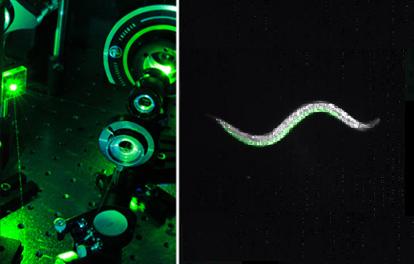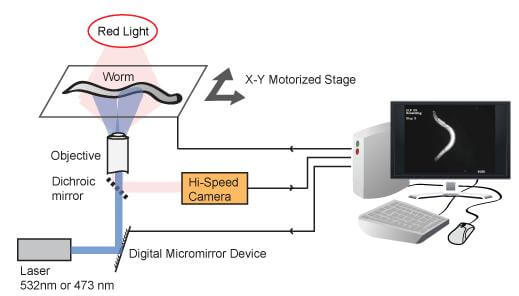
I love cutting edge science, but sometimes it can seem nefarious enough to make a James Bond villain squeal in delight. Researchers at Harvard University have designed a laser system that can control your mind…or at least the mind of a roundworm. These scientists were able to affect the nervous system of a genetically altered C. elegans roundworm by shining lasers on its neurons – allowing them to make it travel in the direction they wanted, paralyze it in place, or even induce it into laying eggs! While previous experiments could affect C. elegans in a similar way, the Harvard team controlled their roundworms while still letting them move freely. In other words, even if the worms tried to run away the mind control laser could still track them down and make them do its bidding. There are some amazing, albeit brief, videos of this system in action – check them out below. For all you evil geniuses out there it’s a little early to start practicing your maniacal laughter, but experiments like this could shed some valuable light on how our nervous systems really work.
Nature didn’t build many animals such that you can control their nervous systems with lasers. That requires some handy genetic splicing. C. elegans were given genes that caused the nerves in their bodies to be responsive to light – sort of like the neurons in your eyes. By shining blue or green light on the worm, different genes in the neurons could be targeted. This powerful technique of genetically modifying cells to be responsive to light is called optogenetics and we’ve already seen it used in mammals. We can expect big things from optogenetics in the future. In the following video, a roundworm has the gene for Channelrhodopsin in its touch nerves. When those cells are exposed to blue laser light, it feels as if it has been touched and swims in the opposite direction. Awesome.
The roundworm in the following video has Halorhodopsin in its motor neurons. When a green laser hits those neurons they are inhibited, resulting in paralysis. Pretty creepy if you imagine the human analog.
In the following video, the C. elegans has two nerves in the middle of its body that have the Channelrhodopsin gene. The laser slowly scans up the body of the worm, and when it reaches these two nerves they become stimulated (around 0:45 or frame 8828). Stimulated to do what? Lay eggs. …I’ll let you imagine your own nightmares for this one.
Making a roundworm recoil from an imaginary touch, freeze up, or poop eggs is fun, but the real innovation here is the setup that makes those actions possible. The C. elegans laser system is known as Controlling Locomotive Behavior in Real Time or CoLBeRT (yes, named after Stephen Colbert). It was created by Aravi Sammuel’s lab at Harvard University, and represents a great step forward in animal testing for neuroscience. CoLBeRT tracks the position of a moving roundworm at 50 frames per second, then using a digital micromirror device, the system can shine laser light on a target with a precision of about 30 microns. C. elegans, which is about 1mm long, is digitally divided into 100 segments that CoLBeRT can aim for. Because CoLBeRT is so fast, scientists can let the worm roam freely, tracking it through its specimen dish, and readjusting its position using a mechanized platform. Here is perhaps the first system that lets you stimulate an animal in this way without really impairing its movement at all. That’s huge. The development of CoLBeRT, and its testing on C. elegan was recently documented in the journal Nature Methods.

Early prototypes of CoLBeRT were developed by Andrew Leifer in the Sammuel Lab. In the following video Leifer gives a quick tour of a CoLBeRT predecessor (the real version probably doesn’t use a recycling bin). He explains how the system can track and then illuminate the tiny roundworm.
I’ve been rather glib about calling this system ‘mind control’ and making mad scientist references. Hey, the computer code for CoLBeRT is actually called “Mind Control” so you can hardly blame me. (Seriously, it’s available for free, check it out. Uses OpenCV, too.) The truth is, however, that CoLBeRT isn’t important because it alludes to the possibilities of mind control in humans, it’s important because it could shine some really valuable light on how our nervous systems control our bodies.
C. elegans only has 302 neurons, and CoLBeRT can target very small groups of nerves (as you saw in the egg video). The precision allows the Sammuel Lab to test what each group of nerves does and how they interact. With such great control over a simple system they could learn a lot about the ways neurons pass signals, and how signals are coordinated for big actions like swimming.
For now, the Sammuel Lab is working with little roundworms, but optogenetics like this can be applied to much larger animals such as mice. Eventually I think techniques like CoLBeRT could provide insights into how human minds work. Not just movements, but emotions, and complex thoughts as well. We’re looking at a very early step on the path to mapping the mechanics of our nervous system. That’s exciting. Maybe not “mind-controlling your neighbors with a laser pointer” exciting, but still pretty cool.
If you’ve enjoyed the clips of manipulated C. elegans, you can find more videos of CoLBeRT controlling worms here.
[image credit: Elizabeth Kane, Sammuel Lab, Leifer et al]
[sources: Leifer et al, 2011 Nature Methods; Sammuel Lab]


